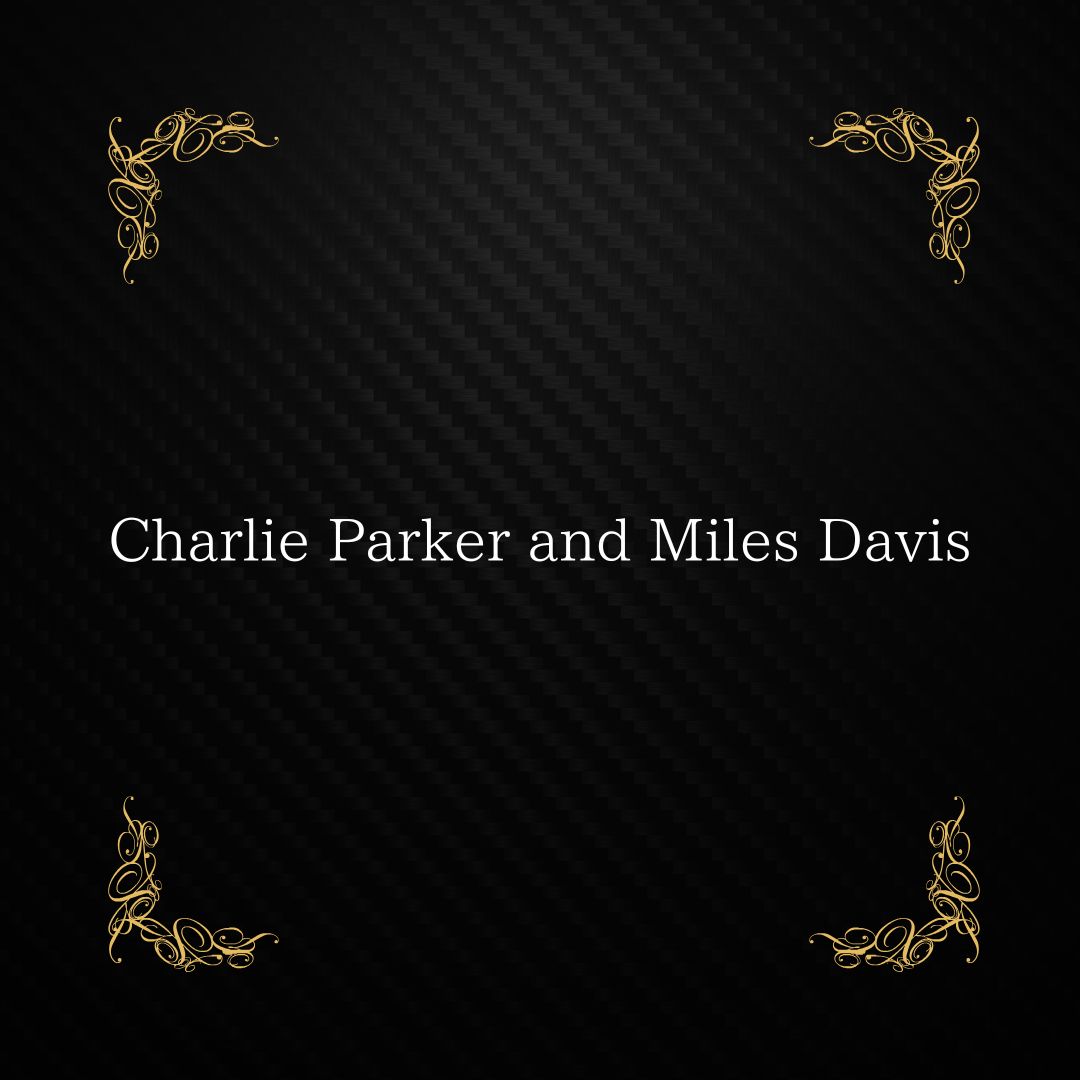Charlie Parker and Miles Davis
チャーリー・パーカー(Charlie Parker)とマイルス・デイヴィス(Miles Davis)は、1940年代のビバップ革命の中心人物 でした。パーカーはサックス奏者として ビバップの創始者 の一人であり、マイルスは 若きトランペッターとして彼のバンドで頭角を現しました。二人の関係は 師弟関係であり、時に衝突しながらもお互いに影響を与え合った ものでした。
Charlie Parker and Miles Davis were central figures in the bebop revolution of the 1940s. Parker was one of the original founders of bebop as a saxophonist, and Miles rose to prominence as a young trumpeter in Davis’ band. The relationship between the two was one of master and pupil, and while they sometimes clashed, they influenced each other greatly.
出会いと初期の関係(1944年〜)
1944年、マイルス・デイヴィスは ジュリアード音楽院 に入学するためニューヨークへやってきました。しかし、彼の本当の目的は学校でクラシック音楽を学ぶことではなく、パーカーやディジー・ガレスピーといったビバップの巨匠たちと演奏すること でした。
当時、チャーリー・パーカーはすでに モダン・ジャズの革命児 として評価されていました。彼のサックスプレイは圧倒的に速く、フレージングも複雑で、誰もが真似できるものではありませんでした。
マイルスはすぐにパーカーの演奏に魅了され、クラブ「ミントンズ・プレイハウス」や「モンクス・プレイハウス」で彼のプレイを聴きに行くようになります。そして 1945年、マイルスは19歳でパーカーのバンドに正式加入 します。
Meeting and early relationship (1944-)
In 1944, Miles Davis came to New York to attend the Juilliard School of Music, but his real goal wasn’t to study classical music at the school, but to play with bebop greats like Parker and Dizzy Gillespie.
At the time, Charlie Parker was already recognized as a revolutionary of modern jazz. His saxophone playing was overwhelmingly fast and his phrasing was complex, making it impossible for anyone to imitate.
Miles was soon captivated by Parker’s playing and began going to see him play at clubs such as Minton’s Playhouse and Monk’s Playhouse, and in 1945, at the age of 19, he officially joined Parker’s band.
チャーリー・パーカー・クインテット時代(1945年〜1948年)
この時期のマイルスは、まだ技術的には未熟でした。パーカーのバンドでは ディジー・ガレスピーのような超絶技巧派のトランペッターが求められていた ため、マイルスの落ち着いたプレイはやや異質でした。しかし、パーカーはそんな彼を見捨てることなく、重要なレコーディングに参加させ続けました。
初めてのレコーディング(1945年)
マイルスは、パーカーのバンドで「Now’s the Time」「Billie’s Bounce」などの名曲をレコーディングしました。しかし、マイルス自身は 「自分の演奏はまだ未熟で、パーカーのレベルには全く達していなかった」と振り返っています。
Charlie Parker Quintet (1945-1948)
Miles was still technically immature at this time. Parker’s band was looking for a virtuoso trumpeter like Dizzy Gillespie, so Miles’s calm playing was a bit of an oddity. But Parker didn’t abandon him and continued to include him in his important recordings.
First recording (1945) Miles recorded classics such as “Now’s the Time” and “Billie’s Bounce” with Parker’s band. However, Miles himself reflected that “my playing was still immature and not at all on Parker’s level.”
バードランドでの大惨事(1946年)
パーカーはこの時期、ヘロイン中毒が深刻化 していました。ある日、クラブ「バードランド」で演奏中に薬物の影響で倒れてしまい、マイルスはパーカーを介抱することになります。彼はこの経験を通じて、後に 薬物を避ける決意をするようになりました(しかし、完全にクリーンになるのはずっと後のこと)。
マイルスの成長(1947年)
1947年頃から、マイルスは徐々にパーカーのバンドの中で存在感を示し始めます。この頃のレコーディングでは 「Donna Lee」「Cheryl」「Buzzy」 などが有名で、マイルスのトランペットがより滑らかで洗練されたものになっていきます。
Birdland disaster (1946) Parker’s heroin addiction was getting serious during this time. One day, while playing at the club Birdland, he collapsed from the effects of the drug and Miles had to nurse him back to health. This experience led him to decide to stay away from drugs later on (though it would be much later before he would get completely clean).
Miles’ Growth (1947)
From around 1947, Miles gradually began to make his presence known in Parker’s band. His recordings from this time include “Donna Lee,” “Cheryl,” and “Buzzy,” and Miles’ trumpet playing became smoother and more refined.
破綻と決別(1948年〜1949年)
パーカーとマイルスの関係は、次第にギクシャクし始めます。
パーカーのヘロイン中毒が悪化
パーカーの演奏は時に素晴らしかったものの、薬物の影響でステージに現れなかったり、支離滅裂な行動を取ることも増えていきました。マイルスは、そんなパーカーに対して次第に嫌気がさしていきます。
マイルスの音楽的独立
1948年、マイルスはパーカーのバンドを離れ、自身の音楽を追求することを決意します。そして、彼はその後 「クール・ジャズ」の誕生に関与し、まったく新しいスタイルを作り上げていきます。
Bankruptcy and separation (1948-1949)
The relationship between Parker and Miles becomes increasingly strained.
Parker’s heroin addiction worsened. Although Parker’s performances were sometimes great, he would often not show up to shows and would behave incoherently due to the effects of drugs. Miles gradually grew tired of Parker.
Miles’ musical independence In 1948, Miles decided to leave Parker’s band and pursue his own musical career. He would later help create “cool jazz” and create a whole new style.
伝説の「シンフォニー・シッド事件」
ある夜、ラジオDJのシンフォニー・シッドが司会を務めるクラブで、パーカーとマイルスが共演しました。その時、パーカーは極度に酔っており、めちゃくちゃな演奏をしてしまったのです。マイルスはこれを見て「もうこれ以上、この人とはやっていけない」と思い、完全に決別することを決意しました。
The legendary “Symphony Sid incident” One night, Parker and Miles performed together at a club hosted by radio DJ Symphony Sid. Parker was extremely drunk and gave a terrible performance. Miles saw this and thought, “I can’t do this with this person anymore,” and decided to break up with him completely.
その後の関係(1950年〜1955年)
パーカーとマイルスは、その後も何度か共演しましたが、かつてのような関係には戻りませんでした。
パーカーの死(1955年)
1955年、チャーリー・パーカーは 34歳の若さで亡くなります(薬物とアルコールの影響による衰弱)。マイルスは、この訃報を聞いても大きな感傷に浸ることはなく、むしろ「自分の音楽を前に進めるしかない」と決意を固めます。
マイルスの回想
マイルスは自伝の中で、パーカーについてこう語っています。
「バード(パーカー)は天才だった。でも、彼は自己破壊的だった。俺はあんなふうにはなりたくなかった。」
彼はパーカーから多くを学んだものの、彼のように薬物に溺れず、新たな音楽を追求することを選んだのです。
パーカーは 「ビバップの象徴」 として、マイルスに多くの影響を与えました。一方で、マイルスは パーカーの自己破壊的な生き方から学び、「新しいジャズ」を創造していった のです。二人の関係は、ジャズ史において最も重要な「師弟関係」 の一つとして語り継がれています。
Later relationship (1950–1955)
Parker and Miles continued to play together on several occasions after that, but their relationship never regained the way it was before.
Death of Parker (1955) In 1955, Charlie Parker died at the young age of 34 (due to the effects of drugs and alcohol). Miles was not overly emotional upon hearing the news, but rather resolved to “move forward with his own music.”
Miles’ recollections: In his autobiography, Miles said about Parker: “Bird was a genius, but he was self-destructive. I didn’t want to be like him.” Although he learned a lot from Parker, he didn’t get addicted to drugs like Parker, and instead chose to pursue new music.
Parker was a “symbol of bebop” and had a great influence on Miles. Meanwhile, Miles learned from Parker’s self-destructive lifestyle and created “new jazz.” The relationship between the two is remembered as one of the most important “master-disciple” relationships in jazz history.
